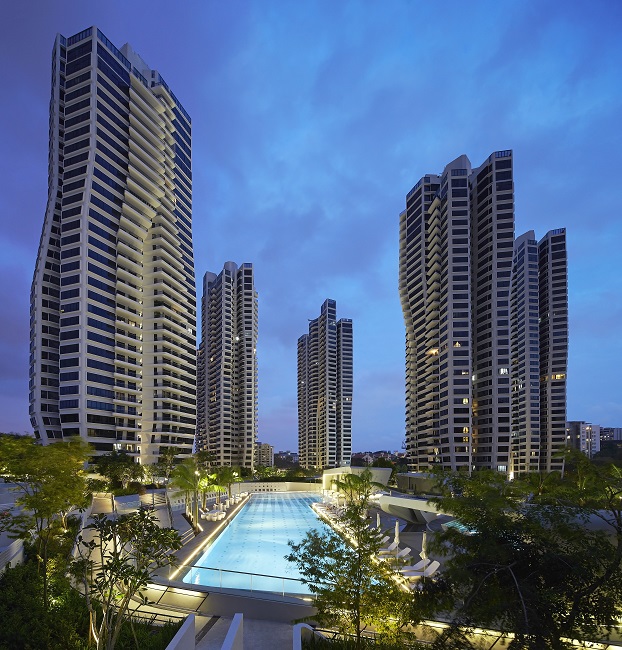D'Leedon, Singapore
Prior to her death in April 2016, Zaha Hadid's firm completed the D'Leedon complex in Singapore. The development comprises 7 residential towers, 12 semi-detached villas and integrated landscaping with recreation facilities.
Each of the seven towers taper inwards as they reach the ground to optimise public space with a unique petal-shaped layout which allows for windows on three sides of the apartments and cross-air flows to the living rooms and bedrooms as well as natural ventilation in all kitchens and bathrooms.
Zaha Hadid Architects designed d'Leedon as a high-rise residential development that provides highly-differentiated apartment layouts according to the specific needs of the residents.
The generative floor plan of the petal changes shape along the height of the tower in relation to the different configuration and type of residential units. The changing composition of unit type enables the towers to respond to a series of parameters dictated by site conditions, internal organisation and structural optimisation.
An innovative concrete shuttering systems was developed to allow the construction of columns at varying angles. The balconies and the bay windows were pre-cast on site and craned to position to be bonded to the structure as the tower was climbing.
Double curved concrete façade panels were prefabricated from GRC off site, and used as permanent moulds giving a very high level of exterior finish to a complex geometry. The concrete was simply finished with render and white paint, leaving the floor structural joints marked. This simple surface treatment highlights the mass while providing the required level of consistency and quality of finishes that a high-end residential development demands.
Environmental considerations and the location along the equator determined the orientation of the towers along the East-West axis in order to optimise solar gain. Sustainable features were introduced to allow generation and re-use of energy on site and to minimise its consumption. The development was awarded Gold+ from Singapore's Building and Construction Authority (BCA) Green Mark Scheme for its design approach.
Images courtesy of Hufton + Crow.
Content courtesy of Zaha Hadid Architects
[edit] Find out more
[edit] Related articles on Designing Buildings Wiki:
- 22 Bishopsgate.
- 600 Collins Street, Melbourne.
- Battersea Power Station.
- Development House, Shoreditch.
- Hertsmere House project.
- Kaplan North Masterplan Complex.
- Masaryk Railway Station regeneration.
- Millennium Mills.
- Mixed-use development.
- Nexus.
- One Hyde Park.
- Port House, Antwerp.
- Salerno Maritime Terminal.
- Tebrau Waterfront Residences.
- The Mile.
- US embassy hotel plans.
- Vista Tower, Chicago.
- Zaha Hadid.
Featured articles and news
Gregor Harvie argues that AI is state-sanctioned theft of IP.
Many resources for visitors aswell as new features for members.
Using technology to empower communities
The Community data platform; capturing the DNA of a place and fostering participation, for better design.
Heat pump and wind turbine sound calculations for PDRs
MCS publish updated sound calculation standards for permitted development installations.
Homes England creates largest housing-led site in the North
Successful, 34 hectare land acquisition with the residential allocation now completed.
Scottish apprenticeship training proposals
General support although better accountability and transparency is sought.
The history of building regulations
A story of belated action in response to crisis.
Moisture, fire safety and emerging trends in living walls
How wet is your wall?
Current policy explained and newly published consultation by the UK and Welsh Governments.
British architecture 1919–39. Book review.
Conservation of listed prefabs in Moseley.
Energy industry calls for urgent reform.
Heritage staff wellbeing at work survey.
A five minute introduction.
50th Golden anniversary ECA Edmundson apprentice award
Showcasing the very best electrotechnical and engineering services for half a century.
Welsh government consults on HRBs and reg changes
Seeking feedback on a new regulatory regime and a broad range of issues.
CIOB Client Guide (2nd edition) March 2025
Free download covering statutory dutyholder roles under the Building Safety Act and much more.



























